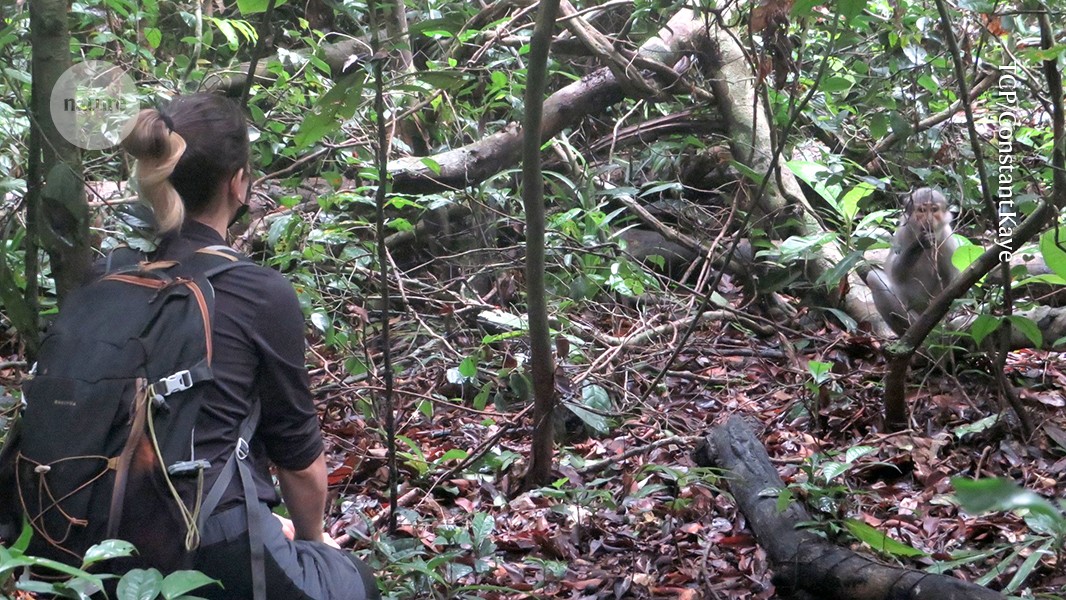An animal source of mpox emerges — and it’s a squirrel

Researchers solve the mystery of a disease outbreak through long-term surveillance of wildlife in Africa
One of the great mysteries of the monkeypox virus has been pinpointing its ‘reservoir’ hosts — the animals that carry and spread the virus without becoming sick from it.
Now, an international team of scientists suggests that it has an answer: the fire-footed rope squirrel (Funisciurus pyrropus), a forest-dwelling rodent found in West and Central Africa1.
Although the name ‘monkeypox’ comes from the virus’s discovery in laboratory monkeys in 1958, researchers have long suspected rodents and other small mammals in Africa of being reservoir hosts. And studies published in the past year2,3 have demonstrated that African outbreaks of mpox, the disease caused by the virus, have been fuelled by several transmission events from animals to humans.
Pinpointing viral reservoirs is crucial to breaking the vicious cycle of transmission, says Placide Mbala, an epidemiologist at the National Institute of Biomedical Research in Kinshasa, the capital of the Democratic Republic of the Congo. By identifying the sources, scientists could work with local communities to design strategies to shield people from infection — for instance, safe handling of wild-animal meat.
The identification of the squirrel is “exceptional” detective work and provides compelling evidence, says Alexandre Hassanin, who studies the evolution of monkeypox at Sorbonne University in Paris. He and others who spoke to Nature, however, aren’t sure that the study definitively establishes F. pyrropus as a monkeypox reservoir, but they applaud the long-term wildlife-surveillance work.
The report was posted as a preprint, ahead of peer review, to the Research Square server on 8 April. (Research Square is owned by Springer Nature, Nature’s publisher.)

Researchers think that the fire-footed rope squirrel could be a reservoir host for the monkeypox virus.Credit: ANT Photo Library/Science Source
Long-term surveillance
Although mpox has affected Africa for decades, it captured headlines worldwide in 2022 when the virus sparked a global outbreak, fuelled by human-to-human transmission. Last August, the World Health Organization declared another global emergency after a worrisome strain of the virus spread to previously unaffected African countries.
As these outbreaks have become more common, one question on researchers’ minds has been their animal sources. A clue emerged in 2023 in Taï National Park in Côte d’Ivoire, where a team of researchers has been monitoring a group of sooty mangabeys (Cercocebus atys) for many years. In late January that year, Carme Riutord-Fe, a disease ecologist at the Swiss Centre of Scientific Research in Abidjan, noticed an infant mangabey with red skin lesions on its forehead, chest and legs. The fluid-filled lesions, characteristic of mpox, quickly spread across its body, and it died two days later.
Within two months, the disease had spread to nearly one-third of the group of 80 mangabeys; 4 of them died. The team identified the monkeypox virus as causing the outbreak and successfully sequenced the full viral genome from two of the infected animals. They were identical, suggesting that the outbreak originated from a single source, says Livia Patrono, a disease ecologist at the Helmholtz Institute for One Health in Greifswald, Germany, and a study author.
But what was the source?
For most outbreak investigations, scientists begin collecting animal samples weeks or months after the first reported cases. Animals don’t always carry detectable levels of the virus, and those responsible for the outbreak might have left the “crime scene” by the time researchers arrive, says Fabian Leendertz, leader of the work and founding director of the Helmholtz Institute. This makes it difficult to pinpoint disease origins, he says.

Leendertz and his team surveil a group of sooty mangabeys to study pathogens, such as the monkeypox virus, that are relevant to humans.Credit: TCP/Ane Lopez-Morales
In the case of the mangabey outbreak, however, “we were there when it happened”, Leendertz says. His team has been monitoring several populations of free-living, non-human primates in the Taï forest on a daily basis since 2001 to better understand pathogens relevant to humans4.
When mpox struck in 2023, archived samples of the mangabeys’ urine and faeces, as well as tissues and swabs from dead animals found in the forest, proved invaluable. Monkeypox virus showed up in faecal samples collected as early as 6 December 2022 from a mangabey called Bako — the mother of the infant that first drew researchers’ attention.
Three pieces of evidence then led the researchers to conclude that Bako, who survived the infection without developing symptoms, had caught the virus after eating a fire-footed rope squirrel. The first was that they observed mangabeys hunt and eat F. pyrropus. The second was that they found an F. pyrropus carcass teeming with a virus identical to the one infecting the mangabeys one month before Bako’s faecal samples turned positive. And finally, they identified F. pyrropus DNA in the earliest positive faecal sample from Bako.
Enjoying our latest content?
Login or create an account to continue
- Access the most recent journalism from Nature's award-winning team
- Explore the latest features & opinion covering groundbreaking research
or
Sign in or create an accountdoi: https://doi.org/10.1038/d41586-025-00990-8
This story originally appeared on: Nature - Author:Jane Qiu















